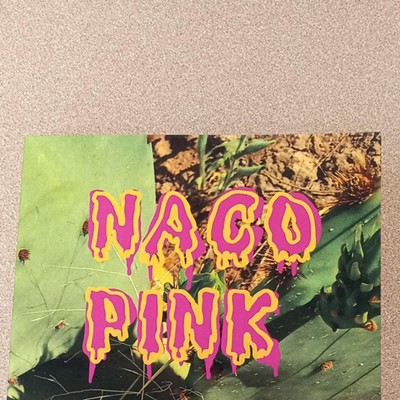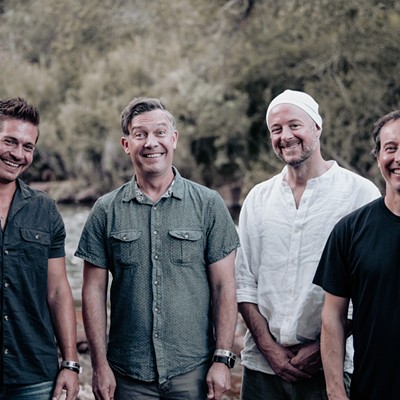On the right, Gail Marcus-Orlen ramps up the crayon-box colors in her surrealistic oils, using lush purples, oranges and teal to paint a kaleidoscope of enchanted figures. From bunnies to birds to little boys, all of them occupy dreamy, imaginary interiors full of stripes and checkerboards.
"Have a Heart" pictures an 1890s couple dressed in twilight blue, formally posed in front of a violet fireplace ringed by apples, pears and butterflies. The wife communes happily with a rabbit, while nearby a dead ringer for the famous Peter Cottontail is hopping down a tabletop bunny trail.
But these cheerful, deeply pigmented paintings are not just about fairy tales. In "Lust" a sensuous blonde woman rises up out of a box and gazes at ripe, peach-colored tulips, her languid frame aching with desire.
And just in time for spring, Marcus-Orlen tosses in a dozen square paintings of birds and blooms in posy pinks and buttercup yellows. As silky as kimonos, these small paintings, from the aptly named Haiku series, are a pure joy.
On the left side of the gallery, Andy Burgess practices what he calls pop geometry. His abstract color collages vibrate in crisp blocks of red and green and mustard (some are made of found matchbook covers, others of vintage linen book covers) and his mid-century modern houses, simplified into triangles, squares and lines, glow pearl white under the blues of an unpolluted California sky.
The lithograph "Pool House" is a diagonal delight, with a bright spring green lawn zipping right, and a cerulean pool cascading left. "Pale Blue Wexler," an acrylic painting, puts the turquoise pool in the foreground, slanting its shimmering waters against a deck dappled with yellow sunlight.
This is all as it should be for a show named Color Theory, a leitmotif that's a perfect match with April in Tucson, where spring-green mesquites are leafing out roadside and yellow poppies are blossoming everywhere.
But how do Kate Breakey's black-and-white photographs in Axial, the narrow entry gallery, fit into the color theme?
They're golden, that's how. Shiny gold gleams through every Breakey image of lakes and mountains, between the trees in her forests, behind her every antique coffeepot, and every desert bird. All part of a new series called Golden Stardust, the 95 works turn the gallery corridor into a glittering magical space or, as gallery director Hannah Glasston has it, a tunnel of gold.
Breakey gets her glimmer from gold foil. She prints the "Stardust" photos on glass and applies the sheets of gold behind the glass. The difficult-to-work-with foil is thick and crinkly, and it adds a delicious texture—almost 3D—to the flat, photographic elements. If you look at "Eucalyptus Tree Fallen Boughs, Kangaroo Island" – and you should—you'll see the golden light flickering through the trees. Look even closer between the branches and you'll see the shiny rough texture of the foil, full of bumps and creases.
Breakey, a prodigiously gifted and productive artist, is a native of Australia who lives in the desert outside Tucson. Restless and creative, she's always trying new things. Just a month or two ago, she exhibited a suite of 34 multimedia photographs at Pima College's Bernal Gallery; she added subtle color to each by painting in encaustic on top of the photo paper. And she made her considerable reputation with an early series that honored dead desert animals: she enlarged the photographic images of birds and lizards to a kingly size and painted them with oils.
The new Stardust series takes its name from the celestial origin of gold. According to scientists, the precious metal is created by the collision of dead stars. It's a happy coincidence for Breakey, who makes not only images honoring the dead, but loves to photograph the skies, especially the moon rising over Arizona peaks or setting over Australian seas.
The new golden work travels across many of Breakey's wide-ranging interests, from animals to landscape to the sea to still lifes. The new "European Starling" and "Gannet" memorialize deceased birds, now shimmering behind glass, and other images single out the singular beauty of a pumpkin, or a butterfly, rendered radiant.
A student of art history, Breakey has made 15 works that pay homage to the still life masterpieces of early Dutch painters. Gathered together in a group, each golden work pictures a single old-fashioned coffeepot or teapot, sprightly standing along in the center of the photo, amber light pouring in.
Her glowing seascapes and landscapes recall the subtle realism of the 19th century Hudson River painters, transplanted Down Under. "Ocean, South Australia" and "Coast, Elliston" picture waves topped by an amber sheen and "Lone Sheoak, Kangaroo Island, South Australia" places a solitary tree in an open landscape touched by stardust.
The three artists in this nicely curated exhibition have multiple links. All are transplants to Tucson from elsewhere; Marcus-Orlen is from Brooklyn and Burgess from London. Each has a rep as a hardworking artist. Burgess has no fewer than 65 works in the show (including photos, collages, lithos and paintings); Breakey has 95; and Marcus-Orlen is hardly a slacker at 19.
And while Marcus-Orlen and Breakey have very different styles, they're linked not only by their images of flowers and butterflies, but by a sense of magic. Burgess goes more for architecture than for nature—or the supernatural, but like the others he's a disciple of color, of ochre and rose and gold.












